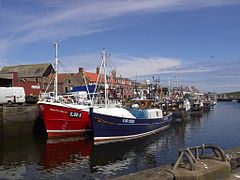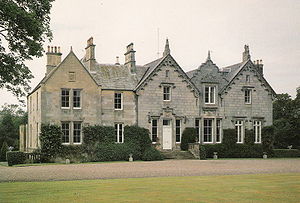Eyemouth
| Eyemouth | |
|---|---|
 Eyemouth Harbour | |
Location within the Scottish Borders | |
| Population | 3,580 (mid-2020 est.)[1] |
| OS grid reference | NT944640 |
| • Edinburgh | 43 mi (69 km) |
| • London | 312 mi (502 km) |
| Civil parish |
|
| Council area | |
| Lieutenancy area | |
| Country | Scotland |
| Sovereign state | United Kingdom |
| Post town | Eyemouth |
| Postcode district | TD14 |
| Dialling code | 01890 |
| Police | Scotland |
| Fire | Scottish |
| Ambulance | Scottish |
| UK Parliament | |
| Scottish Parliament | |
Eyemouth is a small town and civil parish in Berwickshire, in the Scottish Borders area of Scotland. It is two miles (three kilometres) east of the main north–south A1 road and eight miles (thirteen kilometres) north of Berwick-upon-Tweed.
The town's name comes from its location at the mouth of the
Eyemouth is not far from the small villages of Ayton, Reston, St Abbs, Coldingham, and Burnmouth, all in Berwickshire.
The coast offers opportunities for birdwatching, walking, fishing and diving. Accommodation includes several hotels, B&Bs and a holiday park.

A 16th-century artillery fortress

Fort Point at Eyemouth was the site of the first trace-italienne-style fortification in Britain, built on a spur or peninsula overlooking the existing harbour during the war known as the Rough Wooing. Building commenced in 1547 by the English military engineer Sir Richard Lee (1513–1575),[3] and it cost £1,906. Some of the stone was brought from a demolished tower at Dunglass Castle, East Lothian and timber was taken from Coldingham Priory.[4]
The fort was demolished under the
History of Eyemouth
Eyemouth fell within the feudal barony of Coldingham, possessed until the early 17th century by Coldingham Priory, after which it passed to the Home family, who had held lands in that barony since at least the 15th century.[7] All landowners (portioners) within the barony held their properties either by hereditary feu or by a term-renewable, occasionally hereditary, tack (Scots word for a lease) from the barony.
The lands between the southern banks of the Eye Water consisted of three estates: Gunsgreen, immediately opposite Eyemouth and Netherbyres, once part of the larger lands of Flemington which stretched all the way to

Netherbyres was for at least 250 years held by the Craw (originally Auchincraw) family. "George Craw of Netherbyre" was "deceased" by July 1614 when his son William came into possession of that property and Reidhall, "with the walk mill" extending to 12 husbandlands (312 acres (126 hectares)).

Very soon after the cost of getting the tithes removed had been met, the town was struck by the
A contemporary article offers an interesting insight into Eyemouth in the 1860s:
"Between St Abbs Head and Berwick, however is situated Eyemouth, a fishing village pure and simple, with all that wonderful filth scattered about which is a sanitary peculiarity of such towns.
The population of Eyemouth is in keeping with the outward appearance of the place. As a whole, they are rough, uncultivated, and more drunken in their habits than the fishermen of the neighbouring villages.
Coldingham Shore, for instance, is only three miles distant, and has a population of about one hundred fishermen, of a very respectable class, sober and well dressed, and "well to do." – The Fisher Folk of the Scottish East Coast, "Macmillian's Magazine" No.36 October 1862.
In the late 18th century, with the arrival of a group of Dutch engineers in the town, a survey was undertaken for a canal linking Eyemouth to Duns. The plan would have involved damming the Whiteadder Water at Chirnside thus diverting the course of the Whiteadder Water through the low-lying area known as Billiemire to join the Eye Water near Ayton. The plan was never carried out.
From 1891 until 1962, the town was served by a short branch railway line that ran from Burnmouth on the present-day East Coast Main Line. The line was forced to close from August 1948 to June 1949 after being damaged by the flooding of the Eye Water. John Churchill, 1st Duke of Marlborough was created Baron Eyemouth in the Peerage of Scotland in 1682. This was the first of his peerage titles.
Transport
The A1 road, the main Edinburgh – Newcastle route, puts the town within commuting distance of Edinburgh.
Eyemouth railway station served the town until it was closed in 1962. The nearest railway station is Reston railway station, The 253 operated Borders Buses stops at Reston railway station
Education
Eyemouth Public School, in Albert Road, was built in 1876, designed by the architect William Gray Junior.[13]
Children attend Eyemouth Primary School, after which they attend Eyemouth High School.
There is a further education training centre in the town. Northumberland College in Berwick-upon-Tweed is eight miles (13 km) away, and full-time further and higher education courses are offered at Borders College and Heriot-Watt University's textiles campus in Galashiels.
Media
Local news and television programmes are provided by BBC Scotland and ITV Border. Television signals are received from the local relay transmitter. [14]
Eyemouth's local radio stations are BBC Radio Scotland on 94.1 FM and Greatest Hits Radio Scottish Borders and North Northumberland on 103.4 FM.
The Border Telegraph and Southern Reporter are the town's local newspapers. [15][16]
Harbour and industry

In 1997, Eyemouth was given EU funding from a scheme to regenerate declining fishing villages and raised matching funds itself to construct a deep water extension to the harbour. Eyemouth Harbour caters for most types of fishery activity and as a result Eyemouth's primary industry has seen a certain amount of rejuvenation. A
There is a
The
Politics
The elected Eyemouth Town Community Council is led by a Chairman and has 12 members, including an Honorary
Attractions

The wide sandy bay is flanked by high cliffs. Despite being sheltered by Hurkur Rocks, storms can generate high waves and throw high plumes of spume into the air over the sea wall. It is named "The Bantry", said to be in affectionate memory of the Irish labourers from the fishing town of that name in County Cork who constructed it.
The 18 hole golf course and clubhouse have sea views and a restaurant which is open to the public, allowing patrons to enjoy panoramic views as they eat.
Divers come from all over the world to enjoy the St Abbs and Eyemouth Voluntary Marine Reserve with its unique marine flora and fauna.
Eyemouth also has a great leisure centre consisting of a state-of-the-art gym, a studio, a sauna and two swimming pools, one small with a maximum depth of less than 3 feet and a big pool with a minimum depth of 3 feet to a maximum depth of 10 feet.
Nearby places of interest
Other places of interest nearby include the fortifications of
Popular culture
- ITV's Taggartwas filmed on occasion at St Abbs and Coldingham Sands.
- Eyemouth is the setting for a novel by Susanna Kearsley titled The Shadowy Horses.
- Eyemouth is the home of the Queen of the Underworld in H.P. Mallory's series of Jolie Wilkins books.
- Avengers Endgame was filmed at nearby, featuring St Abbs as the harbour town of New Asgard and the overlooking cliffs where Thor asks Valkyrie to be King. Parts of Thor love and Thunder were also filmed at St Abbs
See also
Notes
- ^ "Mid-2020 Population Estimates for Settlements and Localities in Scotland". National Records of Scotland. 31 March 2022. Retrieved 31 March 2022.
- ^ "BBC - Scotland - Coast". www.bbc.co.uk. Archived from the original on 14 August 2005. Retrieved 17 May 2022.
- ^ Skempton, A, Biographical Dictionary of Civil Engineers, vol. 1 (Telford, 2002), 401.
- ^ Marcus Merriman, 'The Forts of Eyemouth: Anvils of British Union?', Scottish Historical Review, 67 (1988), p. 146.
- ^ Marcus Merriman, 'The Forts of Eyemouth: Anvils of British Union?', Scottish Historical Review, 67 (1988), p. 150.
- ^ Pamela E. Ritchie, Mary of Guise in Scotland: A Political Career (East Linton: Tuckwell, 2002), pp. 182, 187: Marcus Merriman, 'The Forts of Eyemouth: Anvils of British Union?', Scottish Historical Review, 67 (1988), pp. 152–154: Amadio Ronchini, 'Lorenzo Pomarelli' in Atti e memorie delle RR. Deputazioni di storia patria per le provincie Modenesi e Parmensi (Modena, 1868), pp. 264-5, and National Records of Scotland E34/21.
- ^ Historic Manuscripts Commission, Manuscripts of Colonel David Milne Home of Wedderburn Castle (London, 1902), p. 26.
- ^ a b Historic Manuscripts Commission, Manuscripts of Colonel David Milne Home of Wedderburn Castle, N.B., London, 1902: 183–4.
- ^ Lawder, Charles A B, The Lawders of The Bass and Their Descendants, Belfast, 1914.
- ^ Anderson, Rev John, Calendar of the Laing Charters, AD854-1837, Edinburgh, 1899: 487.
- ^ Christies Scotland, Netherbyres, Eyemouth, Berwickshire, Glasgow, 1991: 9.
- ^ "Handwoven tapestry from Eyemouth". Scran. Retrieved 3 June 2021.
- ^ "Dictionary of Scottish Architects - DSA Building/Design Report (September 15, 2021, 9:30 pm)".
- ^ "Freeview Light on the Eyemouth (The Scottish Borders, Scotland) transmitter". UK Free TV. Retrieved 8 October 2023.
- ^ "Border Telegraph". British Papers. 23 November 2013. Retrieved 8 October 2023.
- ^ "Southern Reporter". British Papers. 21 January 2014. Retrieved 8 October 2023.
- ISBN 978-1-905400-07-2.
References
Rev. Daniel McIver, An old-time fishing town – Eyemouth, John Menzies, 1906.
Peter Aitchison, Children of the Sea: The Story of the People of Eyemouth, Tuckwell Press Ltd, 2001. Republished ?2007 as Black Friday. (The author is a descendant of William Spears.)
External links
- Eyemouth Town Community Council
- grid reference NT943639
- Eyemouth Chamber of Trade
- St Abbs and Eyemouth Voluntary Marine Reserve
- The Great Disaster and the Eyemouth Tapestry
- The 1881 Disaster Memorials
- Historic photographs of Eyemouth showing life and work in past ages.
- "Plan of Eyemouth fortified 1557, British Library".
- History of Netherbyres House


